25 Forgotten Hoaxes That Fooled The World
Nathan Johnson
Published
04/02/2016
in
wow
Some have even managed to fool millions of people and last for ages or even decades
- List View
- Player View
- Grid View
Advertisement
-
1.
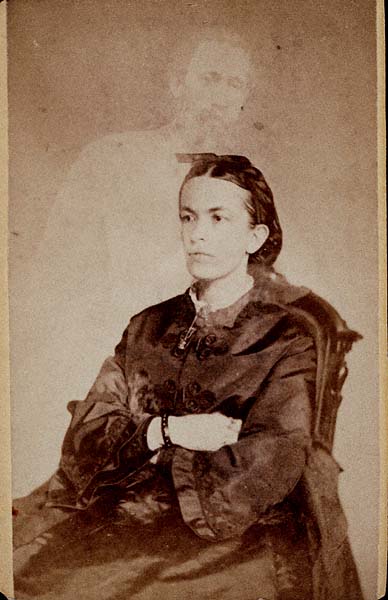 William H. Mumler was an American spirit photographer who worked mainly in New York and Boston. Perhaps his two most famous works are the photograph of Mary Todd Lincoln with the ghost of her dead husband Abraham Lincoln, and his photo of Master Herrod, a medium, with three spirit guides. After being accused of various activities, he was taken to court for fraud, with noted showman P. T. Barnum testifying against him. Though found not guilty, his career was over, and he died in poverty. Today, Mumler’s photos are considered fakes.
William H. Mumler was an American spirit photographer who worked mainly in New York and Boston. Perhaps his two most famous works are the photograph of Mary Todd Lincoln with the ghost of her dead husband Abraham Lincoln, and his photo of Master Herrod, a medium, with three spirit guides. After being accused of various activities, he was taken to court for fraud, with noted showman P. T. Barnum testifying against him. Though found not guilty, his career was over, and he died in poverty. Today, Mumler’s photos are considered fakes. -
2.
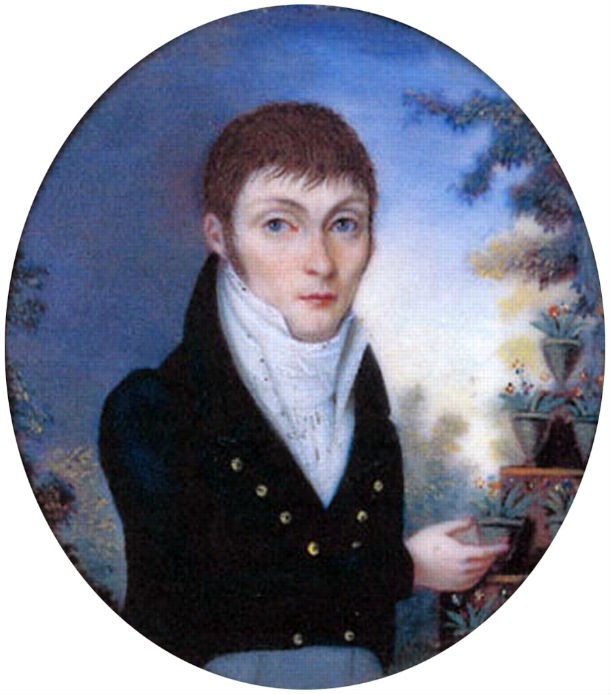 The Walam Olum or Walum Olum, usually translated as “Red Record” or “Red Score,” is purportedly a historical narrative of the Lenape (Delaware) Native American tribe. The document has provoked controversy as to its authenticity since its publication in the 1830s by botanist and antiquarian Constantine Samuel Rafinesque. Ethnographic studies in the 1980s and analysis in the 1990s of Rafinesque’s manuscripts have produced significant evidence that the document is a hoax. Some Delaware people, however, believe Rafinesque based his writing on actual Lenape stories.
The Walam Olum or Walum Olum, usually translated as “Red Record” or “Red Score,” is purportedly a historical narrative of the Lenape (Delaware) Native American tribe. The document has provoked controversy as to its authenticity since its publication in the 1830s by botanist and antiquarian Constantine Samuel Rafinesque. Ethnographic studies in the 1980s and analysis in the 1990s of Rafinesque’s manuscripts have produced significant evidence that the document is a hoax. Some Delaware people, however, believe Rafinesque based his writing on actual Lenape stories. -
3.
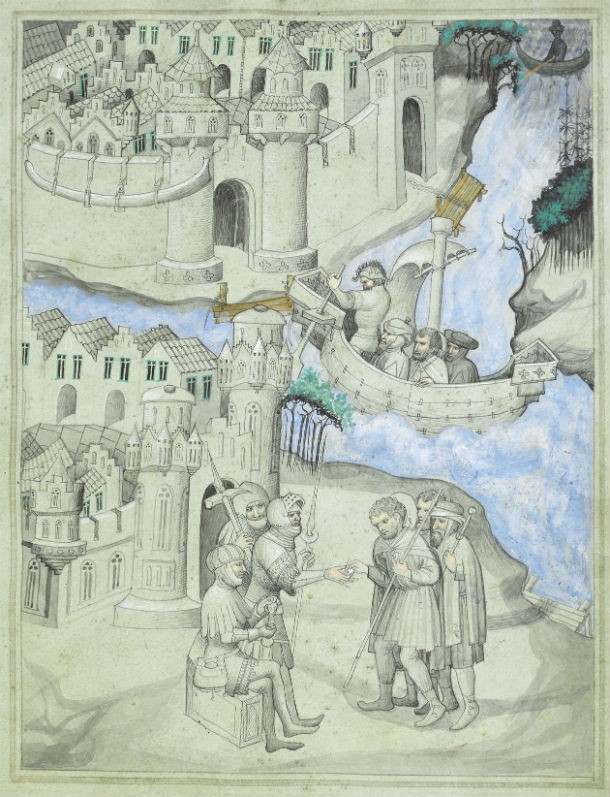 Ostensibly written by an English knight, the Travels claim to relate his experiences in the Holy Land, Egypt, India, and China. Mandeville declares that he served in the Great Khan’s army and to have traveled in “the lands beyond”—countries populated by dog-headed men, cannibals, Amazons, and pygmies.
Ostensibly written by an English knight, the Travels claim to relate his experiences in the Holy Land, Egypt, India, and China. Mandeville declares that he served in the Great Khan’s army and to have traveled in “the lands beyond”—countries populated by dog-headed men, cannibals, Amazons, and pygmies. -
4.
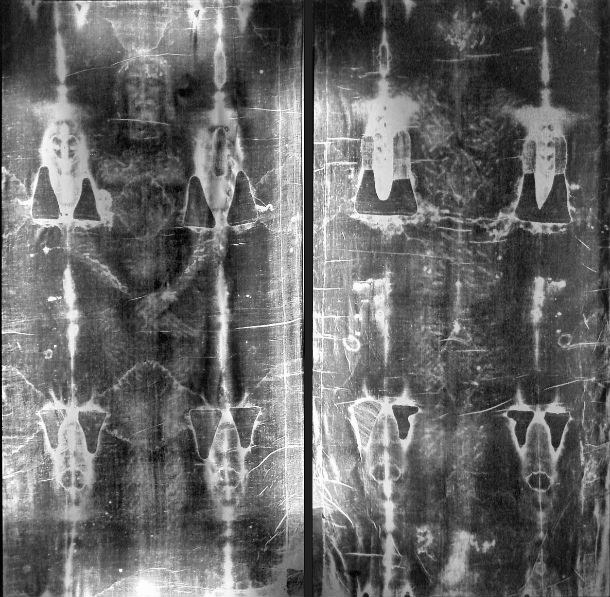 The Shroud of Turin is a length of linen cloth bearing the image of a man that is believed by some Christians to be the burial shroud of Jesus. Three radiocarbon dating tests in 1988 concluded that the age of the cloth only goes back to the Middle Ages.
The Shroud of Turin is a length of linen cloth bearing the image of a man that is believed by some Christians to be the burial shroud of Jesus. Three radiocarbon dating tests in 1988 concluded that the age of the cloth only goes back to the Middle Ages. -
5.
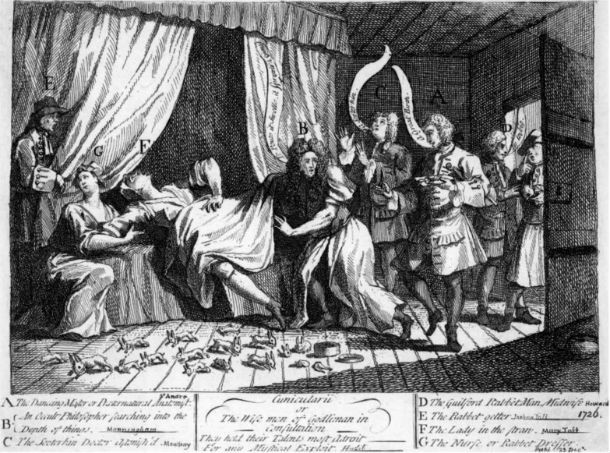 Mary Toft was an Englishwoman from Godalming, Surrey, who in 1726 became the subject of considerable controversy when she tricked doctors into believing she had given birth to rabbits. However, when a famous London physician threatened that he might have to surgically examine Mary’s uterus in the name of science, she confessed she had simply inserted the dead rabbits in her womb when no one was looking, motivated by a desire for fame and the hope of receiving a pension from the king. She was briefly imprisoned for fraud, but released without trial.
Mary Toft was an Englishwoman from Godalming, Surrey, who in 1726 became the subject of considerable controversy when she tricked doctors into believing she had given birth to rabbits. However, when a famous London physician threatened that he might have to surgically examine Mary’s uterus in the name of science, she confessed she had simply inserted the dead rabbits in her womb when no one was looking, motivated by a desire for fame and the hope of receiving a pension from the king. She was briefly imprisoned for fraud, but released without trial. -
6.
 “The War of the Worlds” was an episode of the American radio drama anthology series The Mercury Theatre on the Air. It was performed as a Halloween episode on Sunday, October 30, 1938, and aired over the CBS radio network. Directed and narrated by actor and future filmmaker Orson Welles, it was an adaptation of H. G. Wells’s The War of the Worlds (1898). It became famous for allegedly causing mass panic, although the reality of the panic is disputed as the program had relatively few listeners.
“The War of the Worlds” was an episode of the American radio drama anthology series The Mercury Theatre on the Air. It was performed as a Halloween episode on Sunday, October 30, 1938, and aired over the CBS radio network. Directed and narrated by actor and future filmmaker Orson Welles, it was an adaptation of H. G. Wells’s The War of the Worlds (1898). It became famous for allegedly causing mass panic, although the reality of the panic is disputed as the program had relatively few listeners. -
7.
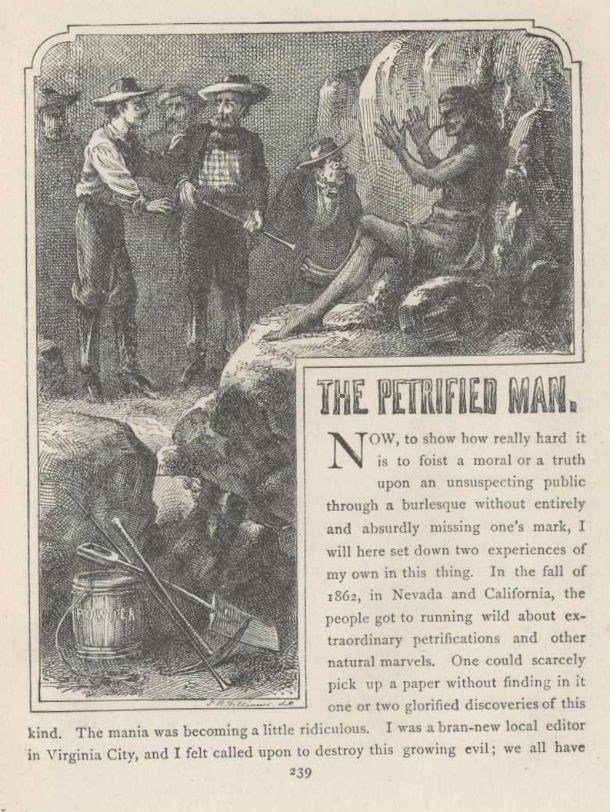 A report that appeared in the Territorial Enterprise (Virginia City, Nevada’s leading newspaper) on October 4, 1862, described the bizarre discovery of a petrified human body. It was a fascinating little blurb. So fascinating that many other papers soon reprinted it. However, not a word of it was true. It had been written by a young man named Samuel Clemens (better known as Mark Twain), who was a new employee of the newspaper. Twain later admitted he was surprised by how many people were fooled by his story.
A report that appeared in the Territorial Enterprise (Virginia City, Nevada’s leading newspaper) on October 4, 1862, described the bizarre discovery of a petrified human body. It was a fascinating little blurb. So fascinating that many other papers soon reprinted it. However, not a word of it was true. It had been written by a young man named Samuel Clemens (better known as Mark Twain), who was a new employee of the newspaper. Twain later admitted he was surprised by how many people were fooled by his story. -
8.
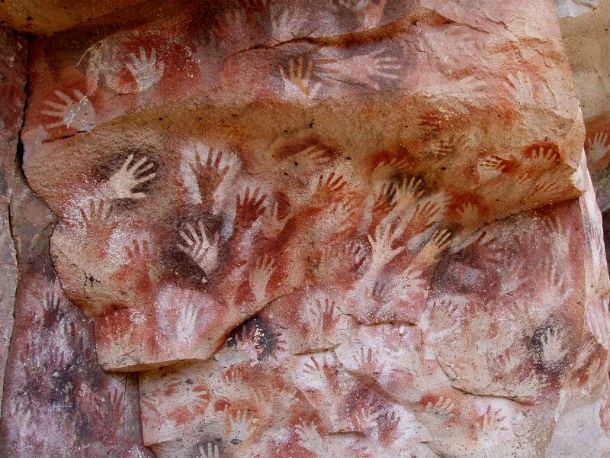 The myth of the Patagonian Giants, like other stories about remote, exotic places, captured the European imagination for a long time. The first mention of this mythical race surfaced in the 1520s in the account of Antonio Pigafetta, chronicler of Ferdinand Magellan’s expedition. For more than 250 years Europe was captivated by the tales of a mysterious group of gigantic people that were called Patagonian Giants but when a newly revised account of the voyage came out in 1773, the Patagonians were recorded as being six feet six inches; very tall indeed, but by no means giants.
The myth of the Patagonian Giants, like other stories about remote, exotic places, captured the European imagination for a long time. The first mention of this mythical race surfaced in the 1520s in the account of Antonio Pigafetta, chronicler of Ferdinand Magellan’s expedition. For more than 250 years Europe was captivated by the tales of a mysterious group of gigantic people that were called Patagonian Giants but when a newly revised account of the voyage came out in 1773, the Patagonians were recorded as being six feet six inches; very tall indeed, but by no means giants. -
9.
 Have you ever heard of George Psalmanazar? No? Well, this Frenchman’s claim to fame was his self-declaration of being the first native of Formosa (today Taiwan) to visit Europe. For some years he convinced many people in Britain, but he was later exposed as a con artist. He subsequently became a theological essayist and a friend of Samuel Johnson and other noted figures of eighteenth-century literary London.
Have you ever heard of George Psalmanazar? No? Well, this Frenchman’s claim to fame was his self-declaration of being the first native of Formosa (today Taiwan) to visit Europe. For some years he convinced many people in Britain, but he was later exposed as a con artist. He subsequently became a theological essayist and a friend of Samuel Johnson and other noted figures of eighteenth-century literary London. -
10.
 On April 28, 1874, the New York World ran an article announcing a German explorer’s discovery in Madagascar of a remarkable new plant species: a man-eating tree. The article included a gruesome description of a woman fed to the plant by members of the local Mkodos tribe. The story was debunked in 1955 by a science writer named Willy Ley, who discovered that not only were the tribe and the tree made up, but so was the German explorer who supposedly found them.
On April 28, 1874, the New York World ran an article announcing a German explorer’s discovery in Madagascar of a remarkable new plant species: a man-eating tree. The article included a gruesome description of a woman fed to the plant by members of the local Mkodos tribe. The story was debunked in 1955 by a science writer named Willy Ley, who discovered that not only were the tribe and the tree made up, but so was the German explorer who supposedly found them. -
11.
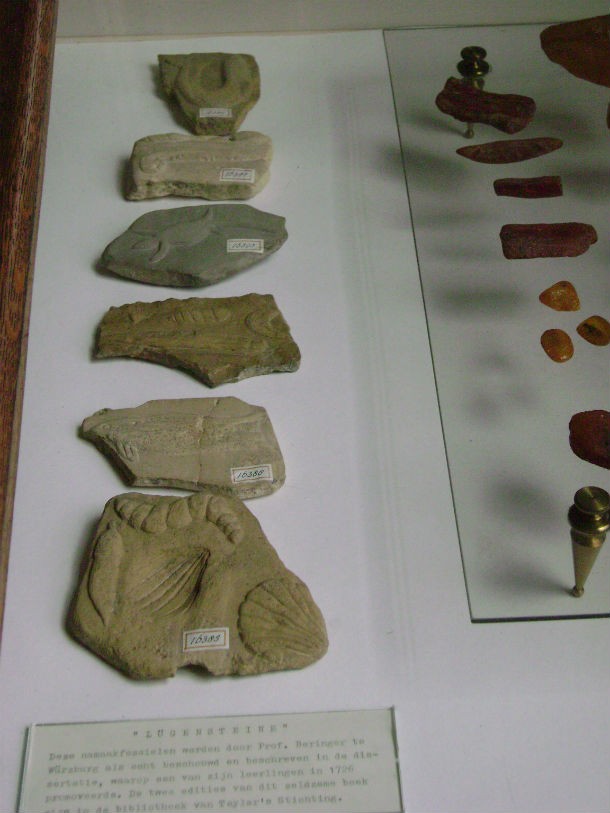 Beringer’s Lying Stones are pieces of limestone carved into the shape of various animals, discovered in 1725 by Dr. Beringer, dean of the Faculty of Medicine at the University of Würzburg. Beringer believed them to be fossils and, because some also bore the name of God in Hebrew, suggested they might be of divine origin. In fact, he was the victim of a hoax, perpetrated on him by his colleagues the ex-Jesuit J. Ignatz Roderick, professor of geography and mathematics, and Johann Georg von Eckhart, privy counselor and university librarian. Upon discovering the truth, Beringer took them to court, and the scandal that followed left all three in disgrace.
Beringer’s Lying Stones are pieces of limestone carved into the shape of various animals, discovered in 1725 by Dr. Beringer, dean of the Faculty of Medicine at the University of Würzburg. Beringer believed them to be fossils and, because some also bore the name of God in Hebrew, suggested they might be of divine origin. In fact, he was the victim of a hoax, perpetrated on him by his colleagues the ex-Jesuit J. Ignatz Roderick, professor of geography and mathematics, and Johann Georg von Eckhart, privy counselor and university librarian. Upon discovering the truth, Beringer took them to court, and the scandal that followed left all three in disgrace. -
12.
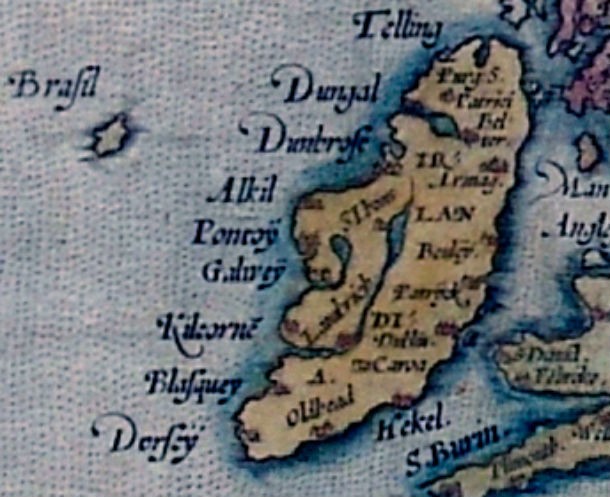 Hy-Brasil is a phantom island believed to lie in the Atlantic west of Ireland. Irish myths describe it as cloaked in mist except for one day every seven years, when it supposedly becomes visible but still unreachable.
Hy-Brasil is a phantom island believed to lie in the Atlantic west of Ireland. Irish myths describe it as cloaked in mist except for one day every seven years, when it supposedly becomes visible but still unreachable. -
13.
 This letter was supposedly written to the Byzantine emperor Manuel I Comnenus (1143–1180) by Prester John, descendant of one of the Three Magi and king of India. The many marvels of richness and magic it contained captured the European imagination, and it was translated into many languages. Part of the letter’s essence was that a lost kingdom of Nestorian Christians still existed in the vastness of Central Asia. As for who really wrote this letter? That remains a mystery to this day.
This letter was supposedly written to the Byzantine emperor Manuel I Comnenus (1143–1180) by Prester John, descendant of one of the Three Magi and king of India. The many marvels of richness and magic it contained captured the European imagination, and it was translated into many languages. Part of the letter’s essence was that a lost kingdom of Nestorian Christians still existed in the vastness of Central Asia. As for who really wrote this letter? That remains a mystery to this day. -
14.
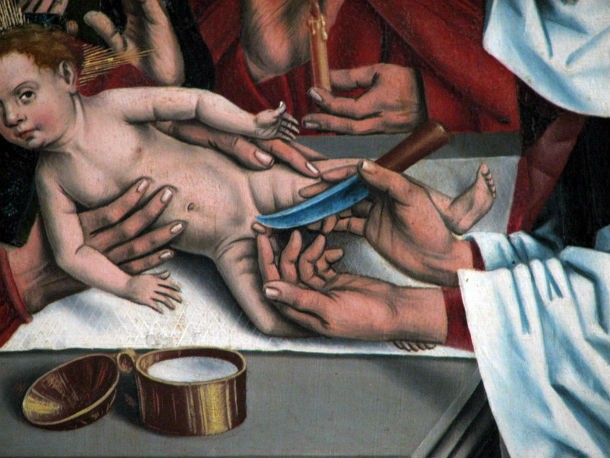 The Holy Prepuce, also known as the Holy Foreskin, was one of many relics attributed to Jesus, a product of his circumcision. Especially during the Middle Ages, many European churches claimed to possess his foreskin, sometimes simultaneously. Of course, it eventually proved to be a hoax.
The Holy Prepuce, also known as the Holy Foreskin, was one of many relics attributed to Jesus, a product of his circumcision. Especially during the Middle Ages, many European churches claimed to possess his foreskin, sometimes simultaneously. Of course, it eventually proved to be a hoax. -
15.
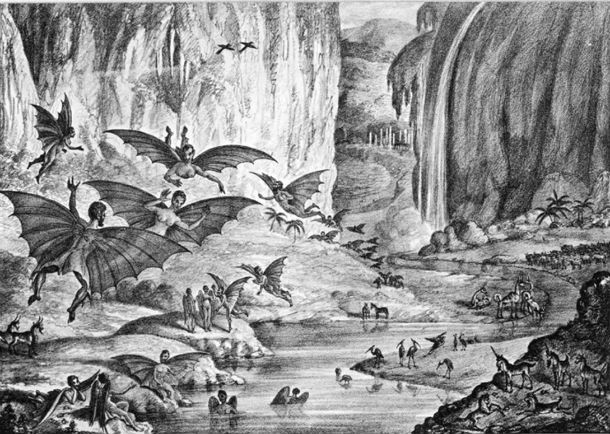 The Great Moon Hoax, which shouldn’t be confused with moon-landing conspiracy theories, was a series of six articles published in The Sun, a New York newspaper, beginning on August 25, 1835, about the supposed discovery of life and even civilizations on the moon. The discoveries were falsely attributed to Sir John Herschel, one of the best-known astronomers of his day.
The Great Moon Hoax, which shouldn’t be confused with moon-landing conspiracy theories, was a series of six articles published in The Sun, a New York newspaper, beginning on August 25, 1835, about the supposed discovery of life and even civilizations on the moon. The discoveries were falsely attributed to Sir John Herschel, one of the best-known astronomers of his day. -
16.
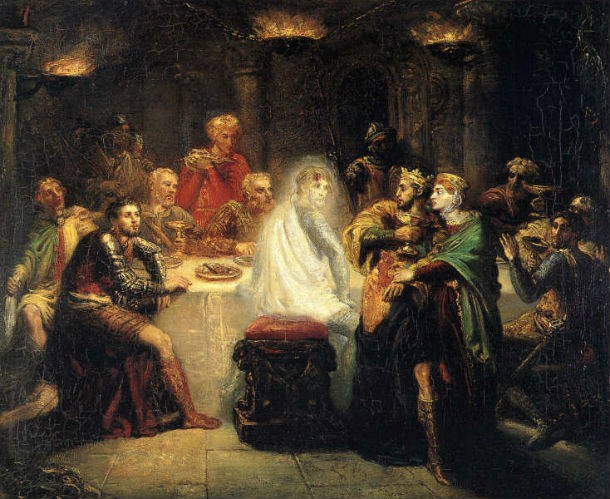 The Ghostly Drummer of Tedworth was a case of suspected poltergeist activity. In the early 1660s John Mompesson of Wiltshire began to hear strange noises in his home. There was the sound of a drum beating, as well as scratching and panting noises. Objects seemed to move on their own, and sometimes a strange sulfurous smell lingered in the air. Skeptics, of which there were many, dismissed the whole thing as a hoax, because as usually happens in such cases, there was not enough proof.
The Ghostly Drummer of Tedworth was a case of suspected poltergeist activity. In the early 1660s John Mompesson of Wiltshire began to hear strange noises in his home. There was the sound of a drum beating, as well as scratching and panting noises. Objects seemed to move on their own, and sometimes a strange sulfurous smell lingered in the air. Skeptics, of which there were many, dismissed the whole thing as a hoax, because as usually happens in such cases, there was not enough proof. -
17.
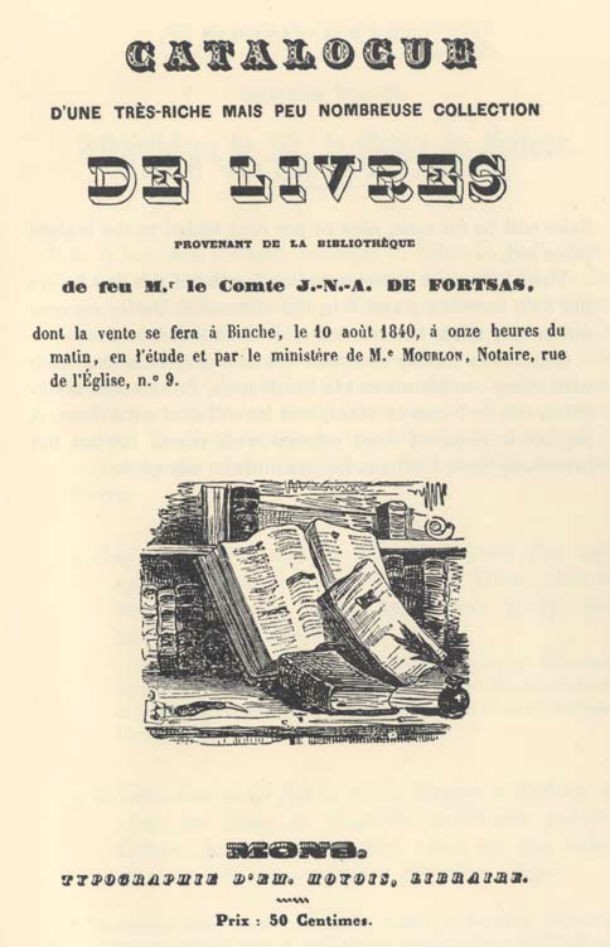 The Fortsas hoax refers to an incident in Binche, Belgium, in 1840. That year, booksellers, librarians, and collectors of rare books throughout Europe received a catalogue describing a collection of rare books to be auctioned. According to the message a man named Jean Nepomucene Auguste Pichauld, Comte de Fortsas, had been a collector of unique books—books of which only one copy was known to exist. When he died, on September 1, 1839, he was in possession of fifty-two such books. His heirs, not interested in collecting books, had decided to auction the collection. The auction was to be held on August 10, 1840, but when the many collectors gathered in Binche hoping to bid on the books, they discovered they had been the victims of a man who loved pranking people.
The Fortsas hoax refers to an incident in Binche, Belgium, in 1840. That year, booksellers, librarians, and collectors of rare books throughout Europe received a catalogue describing a collection of rare books to be auctioned. According to the message a man named Jean Nepomucene Auguste Pichauld, Comte de Fortsas, had been a collector of unique books—books of which only one copy was known to exist. When he died, on September 1, 1839, he was in possession of fifty-two such books. His heirs, not interested in collecting books, had decided to auction the collection. The auction was to be held on August 10, 1840, but when the many collectors gathered in Binche hoping to bid on the books, they discovered they had been the victims of a man who loved pranking people. -
18.
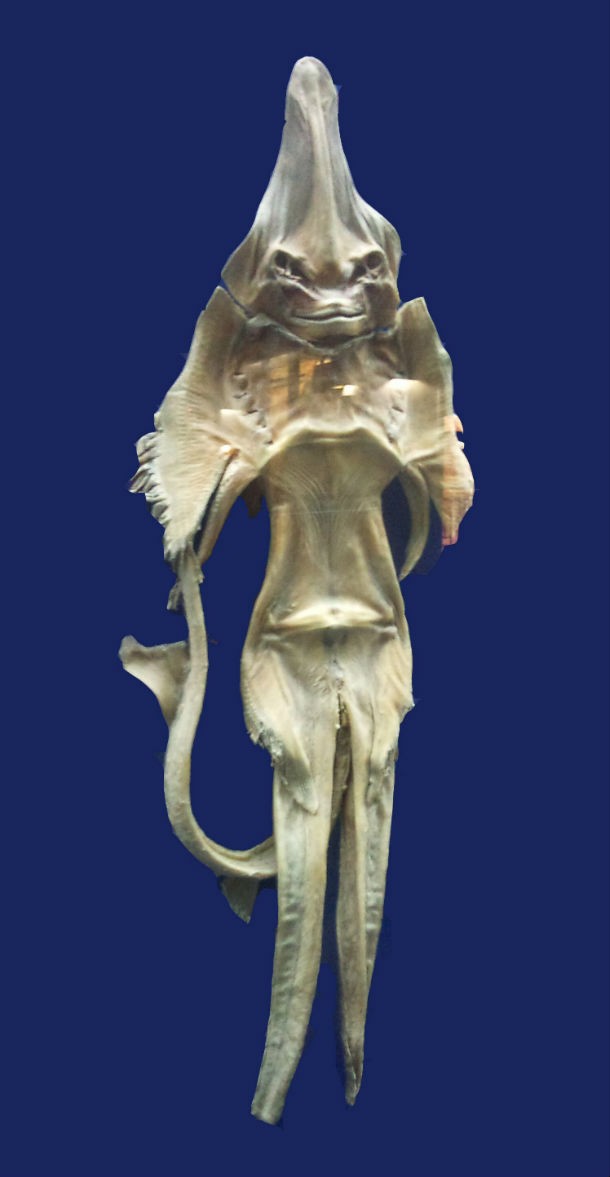 The Fiji mermaid, also known as the Feejee mermaid, was an object comprising the torso and head of a young monkey sewn to the back end of a fish. It was a common feature of sideshows back in the 1840s, where it was presented as the mummified body of a creature that was supposedly half mammal and half fish, a version of a mermaid. The mermaid was supposedly caught near the Fiji Islands but no real evidence was ever found proving the existence of such a creature.
The Fiji mermaid, also known as the Feejee mermaid, was an object comprising the torso and head of a young monkey sewn to the back end of a fish. It was a common feature of sideshows back in the 1840s, where it was presented as the mummified body of a creature that was supposedly half mammal and half fish, a version of a mermaid. The mermaid was supposedly caught near the Fiji Islands but no real evidence was ever found proving the existence of such a creature. -
19.
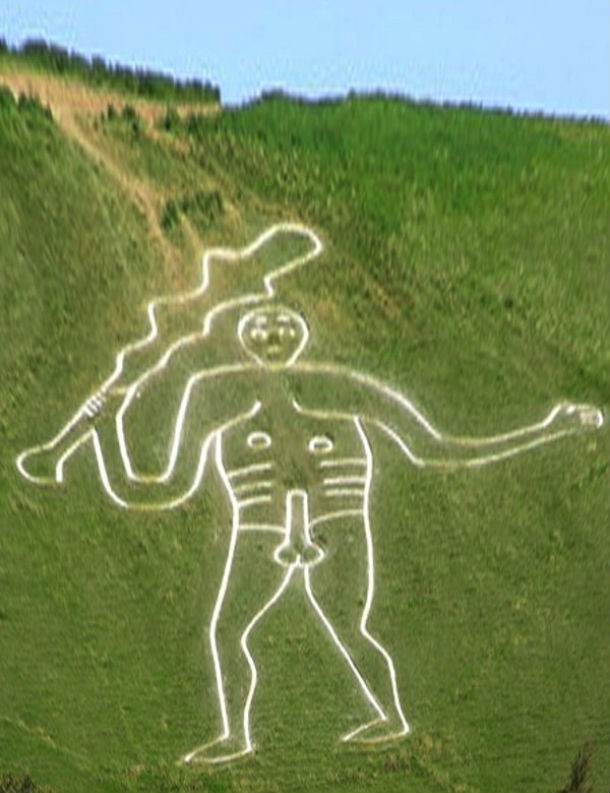 The Cerne Abbas Giant is a hill figure near the village of Cerne Abbas in Dorset, England. Made by a turf-cut outline filled with chalk, it depicts a large naked man with a substantial erection, typically described as a giant wielding a club. It was originally said to be of truly ancient origin, but in recent years historians have suggested that the giant may date only to the seventeenth-century, since the first written reference to it only dates to 1694. Furthermore, its creation is believed to be a prank, a product of the notorious British black humor.
The Cerne Abbas Giant is a hill figure near the village of Cerne Abbas in Dorset, England. Made by a turf-cut outline filled with chalk, it depicts a large naked man with a substantial erection, typically described as a giant wielding a club. It was originally said to be of truly ancient origin, but in recent years historians have suggested that the giant may date only to the seventeenth-century, since the first written reference to it only dates to 1694. Furthermore, its creation is believed to be a prank, a product of the notorious British black humor. -
20.
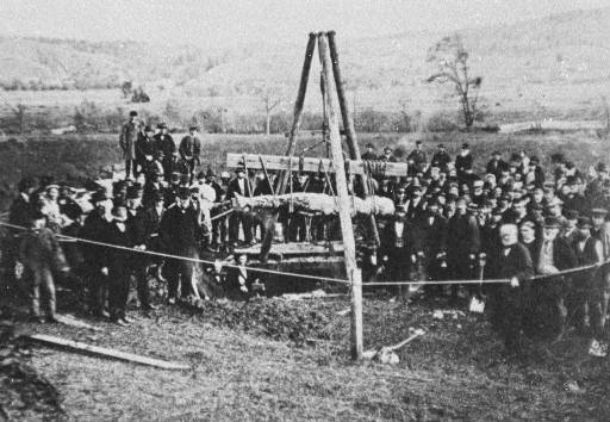 The Cardiff Giant was one of the most famous hoaxes in US history but it is now forgotten. It was a ten-foot tall “petrified man” uncovered on October 16, 1869, by workers digging a well behind the barn of William C. “Stub” Newell in Cardiff, New York. The giant was the creation of a New York tobacconist named George Hull. Hull was an atheist and he decided to create the giant after an argument at a Methodist revival meeting about Genesis 6:4 stating that there were giants who once lived on Earth. Both it and an unauthorized copy made by P. T. Barnum are still on display.
The Cardiff Giant was one of the most famous hoaxes in US history but it is now forgotten. It was a ten-foot tall “petrified man” uncovered on October 16, 1869, by workers digging a well behind the barn of William C. “Stub” Newell in Cardiff, New York. The giant was the creation of a New York tobacconist named George Hull. Hull was an atheist and he decided to create the giant after an argument at a Methodist revival meeting about Genesis 6:4 stating that there were giants who once lived on Earth. Both it and an unauthorized copy made by P. T. Barnum are still on display. -
21.
 The Calaveras Skull was a human skull found in 1866 by miners in Calaveras County, California, which was purported to prove that humans, mastodons, and elephants had coexisted in California. It was later revealed to be a hoax. Ironically, calaveras is the Spanish word for “skulls.”
The Calaveras Skull was a human skull found in 1866 by miners in Calaveras County, California, which was purported to prove that humans, mastodons, and elephants had coexisted in California. It was later revealed to be a hoax. Ironically, calaveras is the Spanish word for “skulls.” -
22.
 In 1593 reports began to spread about seven-year-old Christoph Müller from Silesia (a region of Central Europe now located mostly in Poland), who had naturally grown a golden tooth. It was later discovered to be a fraud by a doctor who examined the boy, but it is still considered one of the first documented cases of a gold crown made for a tooth.
In 1593 reports began to spread about seven-year-old Christoph Müller from Silesia (a region of Central Europe now located mostly in Poland), who had naturally grown a golden tooth. It was later discovered to be a fraud by a doctor who examined the boy, but it is still considered one of the first documented cases of a gold crown made for a tooth. -
23.
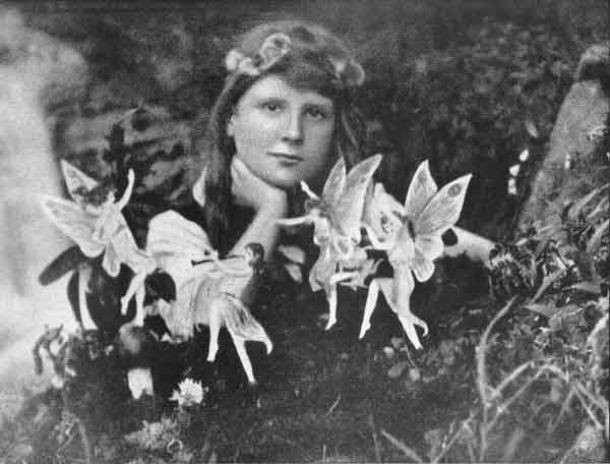 Known as the Cottingley Fairies, this case consisted of a series of photos taken by two young cousins in 1917. The images went viral, even fooling Sir Arthur Conan Doyle (creator of the detective Sherlock Holmes), who viewed them as clear proof of the existence of fairies. It wasn’t until 1983 that the two girls, who were grandmothers by then, finally admitted they faked the photos by using cardboard cutouts.
Known as the Cottingley Fairies, this case consisted of a series of photos taken by two young cousins in 1917. The images went viral, even fooling Sir Arthur Conan Doyle (creator of the detective Sherlock Holmes), who viewed them as clear proof of the existence of fairies. It wasn’t until 1983 that the two girls, who were grandmothers by then, finally admitted they faked the photos by using cardboard cutouts. -
24.
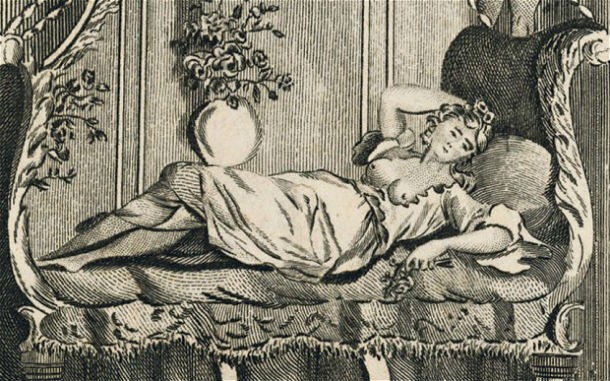 Dr. Graham set out to bring the sublime into the sex life of every married couple. Widely considered the world’s first sex therapist, he guaranteed both ecstasy and fertility to the users of his infamous Celestial Bed, a contraption that harnessed all the most exciting developments of the Enlightenment. Electricity, magnetism, mind-altering gases, and music all played a part in this astonishing invention, luxuriously designed to produce pleasure and perfect babies. Unfortunately for him, the results weren’t so great and his promising celestial bed was exposed as an ordinary bed soon after its release.
Dr. Graham set out to bring the sublime into the sex life of every married couple. Widely considered the world’s first sex therapist, he guaranteed both ecstasy and fertility to the users of his infamous Celestial Bed, a contraption that harnessed all the most exciting developments of the Enlightenment. Electricity, magnetism, mind-altering gases, and music all played a part in this astonishing invention, luxuriously designed to produce pleasure and perfect babies. Unfortunately for him, the results weren’t so great and his promising celestial bed was exposed as an ordinary bed soon after its release. -
25.
 An eight-page pamphlet published in Paris in February 1637 described an unusual case of pregnancy without intercourse. Magdeleine d’Auvermont of Grenoble had supposedly given birth to a son, Emmanuel, without having sex. She claimed she dreamed of having sex with her husband, and the next morning had felt the signs of pregnancy. Nine months later she gave birth but her claims were exposed as false and the story was later declared a hoax.
An eight-page pamphlet published in Paris in February 1637 described an unusual case of pregnancy without intercourse. Magdeleine d’Auvermont of Grenoble had supposedly given birth to a son, Emmanuel, without having sex. She claimed she dreamed of having sex with her husband, and the next morning had felt the signs of pregnancy. Nine months later she gave birth but her claims were exposed as false and the story was later declared a hoax.
- REPLAY GALLERY
-

- 25 Forgotten Hoaxes That Fooled The World
William H. Mumler was an American spirit photographer who worked mainly in New York and Boston. Perhaps his two most famous works are the photograph of Mary Todd Lincoln with the ghost of her dead husband Abraham Lincoln, and his photo of Master Herrod, a medium, with three spirit guides. After being accused of various activities, he was taken to court for fraud, with noted showman P. T. Barnum testifying against him. Though found not guilty, his career was over, and he died in poverty. Today, Mumler’s photos are considered fakes.
25/25
1/25
Categories:
Wow


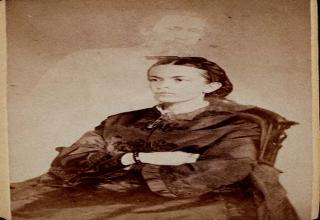





0 Comments